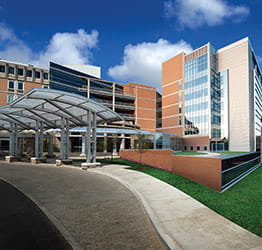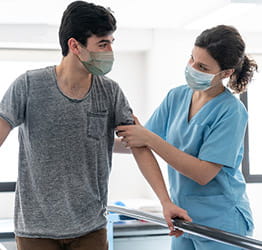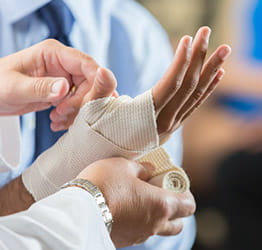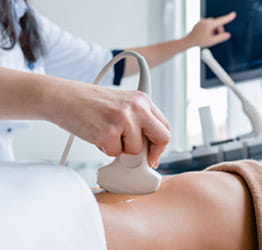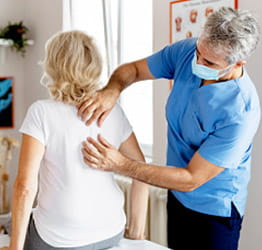What Is Shoulder Replacement?
Shoulder replacement surgery involves removing the original shoulder joint and replacing it with a prosthetic joint.
People with severe arthritis and rotator cuff dysfunction may eventually experience severe pain that affects their ability to perform activities of daily living and have significant limitations to their range of motion and strength. Pain can occur with minimal activities and can impact their sleep.
Shoulder replacement can improve shoulder pain and help restore function. It may be recommended if you have arthritis or shoulder pain and limited function that is impacting your quality of life and ability to perform day-to-day tasks.
What are the types of shoulder replacement surgery?
There are three main types of shoulder replacement:
- Hemiarthroplasty or partial replacement – When only the arm bone (ball joint) portion, and not the socket portion, is replaced. This procedure is typically considered in younger patients with high activity levels, patients who bear weight with their arm, or with fractures of the arm at the shoulder.
- Reverse shoulder arthroplasty (RSA) – Replaces the arm bone portion (ball joint) with a socket, and the socket with a ball – the opposite of natural anatomy. The reverse procedure is used primarily for large, unfixable rotator cuff tears that lead to a special type of arthritis, but is also used in other conditions, including fractures of the arm at the shoulder. It is also used when there is significant bone loss, particularly of the socket, caused by the arthritis.
- Total shoulder arthroplasty (TSA) – Replacement of both the arm bone portion (the ball joint) and the socket portion of the shoulder. It is typically done for wear-and-tear arthritis.
Why Do You Perform Shoulder Replacement Surgery?
The most common problems leading to shoulder replacement are pain and loss of function due to arthritis and rotator cuff dysfunction or tearing.
How common is shoulder replacement?
The National Institutes of Health (NIH) estimates that at least 175,000 shoulder replacement surgeries will be done in 2025, which represents a 67% increase compared to a decade ago. The total number of these surgeries has increased in recent years, thanks mainly to improving technology, which includes an exponential growth in reverse shoulder arthroplasties, which increased by nearly 200% in that same period, in addition to significant improvements in subspecialty training.
When Do You Perform Shoulder Replacement?
Doctors recommend joint replacement surgery when shoulder pain and loss of function become severe and when medicines and other treatments no longer relieve pain. Your doctor will use x-rays to look at the bones and cartilage in your shoulder to see whether they are damaged and to make sure that the pain isn't coming from somewhere else.
Shoulder replacement may not be recommended for people who have:
- Active infection or are at risk for infection.
- Poor general health and may not tolerate anesthesia and surgery well.
- Osteoporosis (significant thinning of the bones).
- Severe weakness of or damage to the muscles around the shoulder.
Some doctors will recommend other types of surgery for younger people, especially those who do strenuous work. A younger or more active person is more likely than an older or less active person to have an artificial shoulder joint wear out and need another replacement surgery in the future.
What are shoulder replacement risk factors and complications?
The risks of shoulder replacement surgery include:
- Blood clots — People can develop a blood clot in a leg vein after shoulder joint replacement surgery, but usually only if they are inactive. Blood clots can be dangerous if they block blood flow from the leg back to the heart or move to the lungs.
- Dislocation or instability of the humerus (upper arm bone). This usually only happens if the soft tissues around the shoulder are stretched too soon after surgery. To help prevent dislocation, it is important to comply with the restrictions recommended by your surgeon after the surgery.
- Fracture of the upper arm bone — An unusual complication, but it may happen either during or after surgery.
- Infection in the surgical wound or the joint — Infection is rare in people who are otherwise healthy. People who have other health problems, such as diabetes, rheumatoid arthritis, or chronic liver disease, and those who take corticosteroids are at higher risk of infection after any surgery.
- Lack of good range of motion — Some people can't move their shoulder far enough to allow them to do their regular daily activities, even after several weeks of recovery. How far you can move your shoulder after surgery depends a lot on how far you could move it before surgery. While most patients improve with their motion, the degree of improvement is highly variable, with some patients regaining their full motion while others have little to no improvement.
- Nerve injury — In rare cases, a nerve may be injured around the site of the surgery. It is usually the result of the surgeon fixing a joint deformity. These injuries usually get better over time and often go away completely.
- Problems with wound healing — While overall wound healing problems are rare, this can occur most commonly in people who take corticosteroids or who have diseases that affect the immune system, such as rheumatoid arthritis and diabetes.
- Prosthesis loosening — Can occur when excessive loads are placed on the shoulder after surgery.
- The usual risks of general anesthesia — Risks of any surgery are higher in people who have had a recent heart attack and those who have chronic (long-term) lung, liver, kidney, or heart disease.
What happens/what does the doctor do during shoulder replacement?
During surgery
In shoulder replacement surgery, surgeons replace the ends of the damaged humerus (upper arm bone) and usually the scapula (shoulder bone). Or the ends may be capped with artificial surfaces lined with plastic or metal and plastic. They may be held in place with cement. Or they may be made with material that allows new bone to grow into the joint component over time to hold it in place without cement.
The top end of the upper arm bone is shaped like a ball. Muscles and ligaments hold this ball against a cup-shaped part of the shoulder bone. Surgeons usually replace the top of the upper arm bone with a metal ball. The metal piece is inserted into your upper arm bone. The size of the metal being inserted into the upper arm can vary depending on the quality of bone and the preference of your surgeon. If the cup-shaped surface of your shoulder bone that cradles your upper arm bone is also damaged, the surgeon will smooth it. Then they cap it with a plastic or metal and plastic piece.
In some cases, surgeons will do a reverse shoulder replacement. It's typically for people who have painful arthritis in their shoulder and damage to the muscles around the shoulder, but it can be placed for other reasons as well.
In this procedure, the surgeon removes the damaged bone and smooths the ends. Then they attach the metal ball portion of the implant to the socket bone. The cup-shaped piece is then inserted into the upper arm bone, where the patient's ball joint used to be. In this implant, the positions of the metal ball joint and the socket implant are reversed.
Doctors often use general anesthesia for joint replacement surgeries. That means you'll be asleep for the entire surgery. Sometimes, surgeons use regional anesthesia. That means you won't be able to feel the area of the surgery. Many surgeons use a combination of both. The choice of anesthesia depends on your doctor, on your overall health, and, to some degree, on what you prefer.
Your doctor will let you know if you will have to stay in the hospital or if you can go home on the day of surgery. Some people stay in the hospital for one to two days. The majority of patients are able to go home the same day of surgery.
If you need any major dental work, your doctor may recommend that you have it done before your surgery. Infections can spread from other parts of the body, such as the mouth, to the artificial joint, causing serious problems.
After surgery
You might receive antibiotics for about a day after the surgery. Pain control is usually very well-managed after the surgery, often through a combination of a regional anesthesia block and oral medications. You may also get medicines to prevent blood clots. It is not unusual to have an upset stomach or feel constipated after surgery. Talk with your doctor or nurse if you don't feel well.
When you wake up from surgery, you will have a bandage on your shoulder, and your arm will be in a sling. You may also have compression sleeves on your legs. These sleeves squeeze the legs to help prevent blood clots. You may keep taking medicines to prevent blood clots for several weeks after surgery.
Most people go home the same day as the surgery. Less frequently, people may stay in the hospital for one to two days.
Postoperative physical therapy
Rehabilitation after a shoulder replacement will start at the discretion of your surgeon. To get the most benefit from your shoulder replacement, you must comply with the physical therapy prescribed for you both in the hospital and at home.
When you begin physical therapy, it is important that you do so under the supervision of a trained physical therapist. There is usually a progression of physical therapy from passive motion to active motion to strengthening. Passive motion means you relax and let the therapist move your arm for you. Active motion is when you move your arm on your own.
At all times, it is important to follow the protocol and restrictions provided to you by your surgeon and therapist. The timeframe for progression to therapy and when you initiate therapy will vary depending on your surgery and recovery. The therapist will also show you what exercises to do at home.
Most people who have shoulder replacement surgery can sit up and get out of bed with some help later on the same day of surgery. Your doctor may teach you to do simple breathing exercises to help prevent congestion in your lungs while your activity level is reduced.
Your recovery
After you go home, watch the surgery site and take care of your general health. If you notice any redness or drainage from the wound, tell your surgeon. You may also be advised to take your temperature twice each day and to let your surgeon know if you have a fever.
You will have an exercise program to follow when you go home, even if you are still having physical therapy. Do the exercises as your physical therapist taught you. Staying on your exercise program will optimize your recovery and outcome.
Rehab includes both physical therapy and your home exercise program and activity. It typically continues in some form until you can function more independently and have recovered as much strength, endurance, and mobility in your shoulder as possible. Total rehab after surgery can take several months.
As your rehab continues, you will slowly be able to do more over several weeks.
The main goal of rehab is to allow you to move your shoulder in a functional way that makes it easier for you to do daily activities, such as dressing, cooking, and driving. Most people improve with their motion after shoulder replacement, but the amount of improvement is highly variable from patient to patient.
Other things that affect how much movement you get back after surgery are how much movement you had before surgery, and whether the soft tissues around your shoulder were also damaged.
Living with a shoulder replacement
Several months are typically necessary to completely recover from shoulder replacement surgery. While every patient is different, there are several phases to recovery.
Most patients are required to wear a sling and limit activities for the first four to six weeks. However, patients with severe pain preoperatively typically find that the pain is significantly better within a week or two of surgery.
Your doctor may want to see you from time to time for several months or more to monitor your shoulder replacement and progress. Over time, you will return to many of your presurgery activities. To completely recover, you'll need to build up the range of motion and strength in your arm. This may take many months.
Stay active to help keep your overall strength, flexibility, and endurance. Your activities might include light yard work, walking, swimming (after your wound is completely healed and your doctor has approved), dancing, and golf. Your doctor may recommend that you avoid heavy lifting and repetitive activities.
After three months, most people feel much more functional than before the surgery. But overall improvement, including overhead strength, may continue to improve up to a year after surgery.
In the future, make sure to let all health professionals know about your artificial shoulder so they will know how to care for you.
Is Shoulder Replacement Right for Me?
The younger you are when you have the surgery, and the more stress you put on the joint, the more likely it is that you will eventually need a second surgery to replace the first artificial joint. Over time, the components wear down or may loosen and need to be replaced.
Your artificial joint should last longer if you do not do repetitive, hard physical work or play sports that stress the joint. Shoulder replacements usually last for about 10 to 20 years.
What to Expect From Shoulder Replacement Surgery
Shoulder replacement surgery is typically a very reliable treatment for pain relief. Most people have much less pain after shoulder replacement surgery and can do many of their daily activities more easily.
- While motion typically improves, your shoulder may not move as far as it did before you started having shoulder problems. But the surgery will allow you to do more of your normal activities without pain.
- After surgery, you may be allowed to resume many activities, such as golfing, riding a bike, swimming, walking for exercise, dancing, or cross-country skiing (if you did these activities before).
- Your doctor may discourage you from doing things that put a lot of stress on the joint, including heavy lifting or heavy repetitive motions.
By UPMC Editorial Staff. Last reviewed on 2025-10-07.





